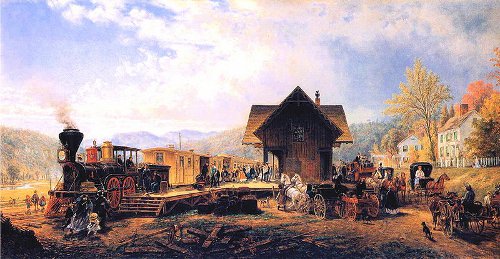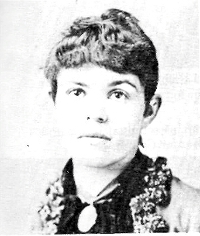
Church Pants
The following story has been told, but I have not met with it in its absolute correctness. The Duke of Wellington received a letter, while sitting in the House of Lords, from an eminent landscape designer and great authority on botanical matters, J.C. Loudon. The duke had lost sight of him for some years. It was a note to this effect: ‘My Lord Duke–It would gratify me extremely if you would permit me to visit Strathfieldsaye at any time convenient to your grace, and to inspect the Waterloo beeches. Your grace’s faithful servant, J.C. Loudon.’ The Waterloo beeches were trees that had been planted immediately after the battle of Waterloo, as a memorial of the great fight. The duke read the letter twice, the writing of which was not very clear, and, with his usual promptness and politeness, replied as follows, having read the signature as ‘J.C. London,’ instead of ‘J.C. Loudon.’ ‘My dear Bishop of London–It will always give me great pleasure to see you at Strathfieldsaye. Pray come there whenever it suits your convenience, whether I am at home or not. My servant will receive orders to show you as many pairs of my breeches as you may wish, but why you should wish to inspect those I wore at the battle of Waterloo is quite beyond the comprehension of Yours most truly, Wellington.’ The letter was received, as may be supposed, with great surprise by the Bishop of London. He showed it to the Archbishop of Canterbury and to other discreet persons; they came to the melancholy conclusion that the great Duke of Wellington had evidently lost his senses. The Bishop of London (Blomfield) declared that he had not written to the duke for two years and to receive this extraordinary intimation puzzled the whole bench of bishops. Explanations, however, of a satisfactory kind, followed and the friendship of these worthy men was not changed.
— William Augustus Fraser, quoted in Wit, Wisdom and Foibles of the Great, 1918
Street Marketing
Physicists Chen Ning Yang and Tsung-Dao Lee used to discuss their work over lunch at a Chinese restaurant on 125th Street in Manhattan. One day they made an important insight into parity violation, and the two received the 1957 Nobel Prize in physics.
After the award was announced, one of them noticed a sign in the restaurant window: “Eat here, get Nobel Prize.”
Bullet Train

On Oct. 15, 1856, the London Times published an alarming account of a rail journey in Georgia — the author, “John Arrowsmith of Liverpool,” claimed that half a dozen duels had broken out during a single day’s ride:
Of the two dozen passengers fifteen are mentioned as entering more or less into the action of the drama; twelve took a direct part in duels; six were killed, and three were left on the way fighting. Four of the duels were fought at convenient spots, the train stopping for the purpose; one was fought in the luggage car while the train was in motion; and the one with uncertain results was fought at a regular stopping place. Three of the dead bodies were left behind; one was carried from the scene of the duel and deposited on the luggage; another lay where it fell in the luggage car; another was throw out on the roadside.
After a torrent of ridicule from the American press, the retraction-shy Times tried to claim that the affair had taken place in 1828 — but that was “some dozen years,” one critic noted, “before the erection of a railroad in Georgia, or the invention of revolvers, the terrible weapons used upon the sanguinary occasion.” The hoaxer was never identified.
Misc
- As Britain prepared for World War I, officers were required to have their swords sharpened.
- Wordsworth’s “The Rainbow” has an average word length of 3.08 letters.
- sin 10° × sin 50° × sin 70° = 1/8
- WILLIAM SHAKESPEARE = I SWEAR HE’S LIKE A LAMP
- “I have always thought that every woman should marry, and no man.” — Benjamin Disraeli
Terms Past
Disused words from Samuel Johnson’s 1755 Dictionary of the English Language:
- figure-flinger: a pretender to astrology and prediction
- pissburnt: stained with urine
- blinkard: one that has bad eyes
- centuriator: a name given to historians, who distinguish times by centuries
- longimanous: long-handed; having long hands
- candlewaster: that which consumes candles; a spendthrift
- carecrazed: broken with care and solicitude
- overyeared: too old
- scarefire: a fright by fire; a fire breaking out so as to raise terror
- traveltainted: harrassed; fatigued with travel
- vowfellow: one bound by the same vow
“Those who have been persuaded to think well of my design, require that it should fix our language, and put a stop to those alterations which time and chance have hitherto been suffered to make in it without opposition,” he had written in the preface. “[But] when we see men grow old and die at a certain time one after another, from century to century, we laugh at the elixir that promises to prolong life to a thousand years.”
That’s No Moon …

NASA’s Cassini spacecraft took this photo while orbiting Saturn in 2005.
Homespun Silk
A publishing sensation swept the United States in 1926: The Diary of a Young Lady of Fashion in the Year 1764-1765 offered scandalous insights into 18th-century society through the observations of one Cleone Knox, who met Louis XV at Versailles, was introduced to Voltaire in Switzerland, and led a pretty eventful private life:
March 3rd [1764]. This morning had a vastly unpleasant interview with my Father. Last night, Mr. Ancaster, who is the indiscreetest young man alive, was seized suddenly while riding home along the shore with the desire to say good night to me. He climbed the wall, the postern gate being locked at that late hour, and had the Boldness to attempt to climb the ivy below my window; while but half way up the Poor Impudent young man fell. (If he hadn’t Lord knows what would have happened for I am terribly catched by the Handsome Wretch.) As ill luck would have it Papa and Ned, who were conversing in the library, looked out at that moment and saw him lying prostrate on the ground!
America swooned, and the book went through nine editions in two months. One critic wrote, “No modern girl will ever write a diary like this. Cleone Knox breathes the very spirit of the witty, robust, patriotic, wicked, hard-drinking, hard-swearing 18th century.”
Alas, a modern girl had. Embarrassed by the publicity, 19-year-old Magdalen King-Hall came forward to say that she had invented the tale using books from the Brighton town reference library. “I wrote the book in a few weeks,” she said, “but, if I had realized so many distinguished people would have taken it seriously, I should have spent much more time and pains upon it.” She had not meant to deceive anyone — but perhaps her publisher had.
Stacking Cubes
43 + 183 + 333 = 41833
163 + 503 + 333 = 165033
223 + 183 + 593 = 221859
443 + 463 + 643 = 444664
483 + 723 + 153 = 487215
983 + 283 + 273 = 982827
The Pimlico Mystery

On Dec. 28, 1885, London grocer Edwin Bartlett was discovered dead in his bed. In his stomach was a fatal quantity of chloroform, but, strangely, his throat and larynx showed no signs of the burning that liquid chloroform should have caused.
Bartlett’s wife, Adelaide, was having an open romance with George Dyson, a local minister. It transpired that she had induced him to buy chloroform at local pharmacies in quantities too small to provoke suspicion, ostensibly to help treat Edwin, who was undergoing painful dental surgeries.
At trial, Adelaide’s defense was simply that she had no way to get the chloroform into Edwin’s stomach without passing it down his throat. The jury let her go.
“Now that Mrs. Bartlett has been acquitted,” remarked pathologist Sir James Paget afterward, “she should tell us, in the interests of science, how she did it.” Adelaide made no response. The puzzle of Edwin’s death has never been solved.
